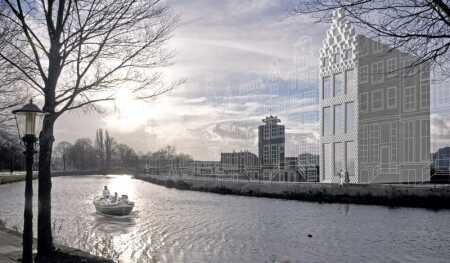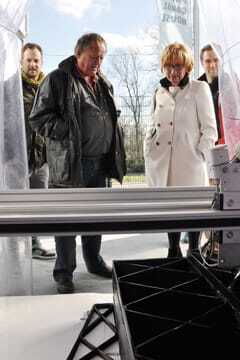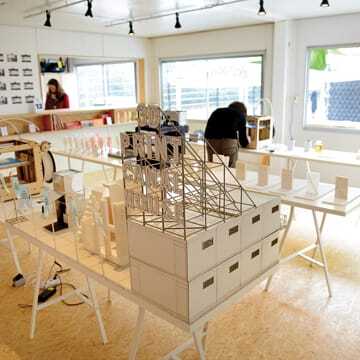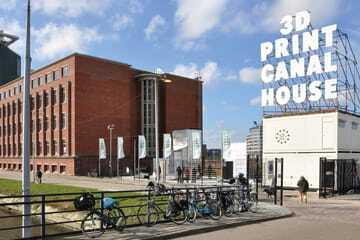Along a canal in the heart of Amsterdam stands the construction site of a house that promises to change real estate forever.
The influence of this house won’t be attributable to the materials and features that so often make buildings famous; at just 20 feet by 20 feet (6 m by 6 m) wide and 50 feet (15 m) tall, it is not distinct because of its size. Rather, this project’s distinction owes everything to the manner of its assembly.
The house will not be built by hand; rather, it will be printed into existence, in its entirety and by one machine—a 3-D printer that manufactures three-dimensional objects from layers of extruded melted material.
The potential of 3-D printing is so far-reaching that its emergence has thrust industries of all kinds into invention mode, seeking ways to harness it to create printed products as varied as underwater reefs, prosthetic limbs, car engines, and airplane parts. Tests are also underway for the technology’s application to the creation of food.
Real estate is part of that rush, with several projects in Europe and the United States racing to complete the first 3-D–printed house. In March, as Amsterdam’s DUS Architects and collaborators launched their own “3-D print canal house” project, that race became a little fiercer.
A Day’s Work
Team Amsterdam hopes the technology will revolutionize the construction of real estate, enabling houses to be built in just one day and providing an alternative to the inefficient and wasteful hand-built process that is currently used.
“We had been printing with smaller printers for a long time, but as architects we wondered what 3-D printing could mean for buildings,” says Hans Vermeulen, cofounder of DUS Architects. “We could recycle waste materials into print materials, eliminate transport costs, and make personalized architecture. You can print buildings, shred them, and print them anew,” he adds.
But DUS’s 3-D printing project also has a social mission, with the company’s founders hoping it has the potential to address the housing needs created by increasing urbanization. “For the first time in history, over half of the world is living in cities. We need a rapid building technique to keep pace with the growth of megacities,” Vermeulen says.
It is a revolution that’s on show for all to see. The public is invited to stop by the building site, which is near the Buiksloter canal in the north of the city, and watch the prototype emerge from DUS’s bespoke “Kamer Maker” (which means room builder) printer.
The house, which will be on display for three years, will be assembled from a digital model. The 20-foot-tall (6 m) Kamer Maker printer, which DUS claims is the world’s largest movable 3-D printer, will make each of the house’s 13 rooms separately. The machine works by “drawing” one layer of a room at a time with melted plastic, leaving spaces for pipes and wiring as it goes. The process looks a bit like a robot icing a giant cake.
Once the architects are satisfied that the rooms are structurally sound, the rooms are connected into floors, which are then stacked to become a house. By being built this way, the house can be taken apart and moved if need be.
The structural aspects of the 3-D print house will be tested digitally and on site in collaboration with structural engineers. “Folds in the structure generate strength,” Vermeulen explains. “Each printed element consists of numerous diagonal hollow columns. When the elements are mounted together, the hollow columns create large structural crosses that support the entire structure.”
Interest in the 3-D printed canal house has come from many sectors—including President Barack Obama, who visited the project during a trip to Amsterdam in March. And developers and real estate bankers are among the many who have visited the Kamer Maker in the gardens of the architecture firm’s Amsterdam practice. “People increasingly understand that development isn’t just about bricks and mortar,” says Vermeulen. “These visitors were interested to see how this technology will be used; they know there’s a market for it.”
Vermeulen has also had conversations with construction firms, concrete companies, accountants, and builders about developing strategies based on the new technology. “These businesses are exploring how open-sourced, internet-based design models will impact their clients,” he says, adding, “3-D printing is already beyond the hype.”
Foundation Alternatives
The inherent mobility of the house—a key aim of the project —will also be aided by an absence of a traditional foundation. DUS, inspired by techniques applied to the pop-up venues for London’s 2012 Summer Olympic Games, is collaborating with construction companies on ways to fix the house to the ground temporarily. Current ideas include pinning the house down with 85-foot-long (26 m) poles.
How the advent of the 3-D print age affects developers is clear to Vermeulen: they must fight for their place in it. He predicts that once fully evolved, 3-D print technology will create a market of “downloadable architecture,” enabling homebuilding to become a “community exercise that allows people to build a neighborhood together.” He says: “Kamer Maker printers can be built all over the world to produce solutions, harnessing the power of the internet and social networks in city making.”
The potential of 3-D printing is such that anyone will be able to go online, download predesigned room templates, and customize them to create their dream house, before placing an order for that house with a contractor in possession of a printer.
“The method makes architecture personal again and bridges the gap between designer, client, and builder,” Vermeulen says. “Community is central to the use of these machines; 3-D printing could totally reorganize the planet and help make better use of resources. These are the goals we’re working toward.”
Developers, he argues, have to become more flexible and better understand what the community needs and what they can do. “Perhaps developers’ role will end up being about creating nice, sustainable public domains,” he says.
On-Demand Interiors
Homeowners will be able to use the process to print on-demand, custom-made interiors, too. “You could 3-D–scan a building structure and then digitally design a bathroom that exactly suits the space,” Vermeulen says. “The new room could be 3-D–printed and inserted on site in a day.”
While the ability to print houses in 24 hours will bring efficiency to homebuilding (most usefully in disaster-relief scenarios), DUS is determined that any new technique be environmentally kind, helping to lower the carbon footprint of the construction process.
While this prototype is being printed with plastic, DUS, along with German material partner Henkel, is researching whether a bio-based material adhesive called “hotmelt” could work with the technology.
“We are looking for the optimal print material—one that offers a 60 percent reduction of a house’s carbon dioxide emissions and allows the house to be recycled in the future,” says Vermeulen.
“Our aim is to develop a renewable, sustainable, strong, tactile, and beautiful material that can compete with current building techniques,” he says. DUS is also exploring whether the Kamer Maker can print facades complete with built-in solar panels. How to print a conducting material that can collect and store water to provide natural heat insulation is another research topic on the agenda.
While the first house will be expensive to build, Vermeulen says the long-term economics of the construction technique “look good.” There is little to no waste in 3-D printing compared with conventional building techniques, he says. Vermeulen estimates that this new method would have 96 percent supply chain efficiency.
And there are other ways the technology can counter the negative aspects of today’s building process. “Less transport will be needed, which will reduce costs, and the construction process can be fully automated. Time can also be organized much more efficiently,” he says. “We can improve the process and do so without reducing quality of output.”
The printed prototype will not be inhabited fully but will be used as a research hub. Over the next three years, DUS and its partners will work on exploring printable renewable materials, as well as ways to improve the printing technology and raise production capacity. As improved methods become available, the structure of the house will change—reflecting 3-D printing’s ongoing evolution.
Vermeulen says it is hard to predict when the technology will be available to the mass market. However, he says, “Three years ago, I’d describe our ideas and people would say, ‘3-D printing—what’s that?’ Now they ask, ‘When is it going to be ready?
“Today this is a concept, a wish, a dream. But as every week goes by, it’s becoming more realistic.”
Lucy Anna Scott is a London-based freelance writer and coeditor of Lost in London magazine.








